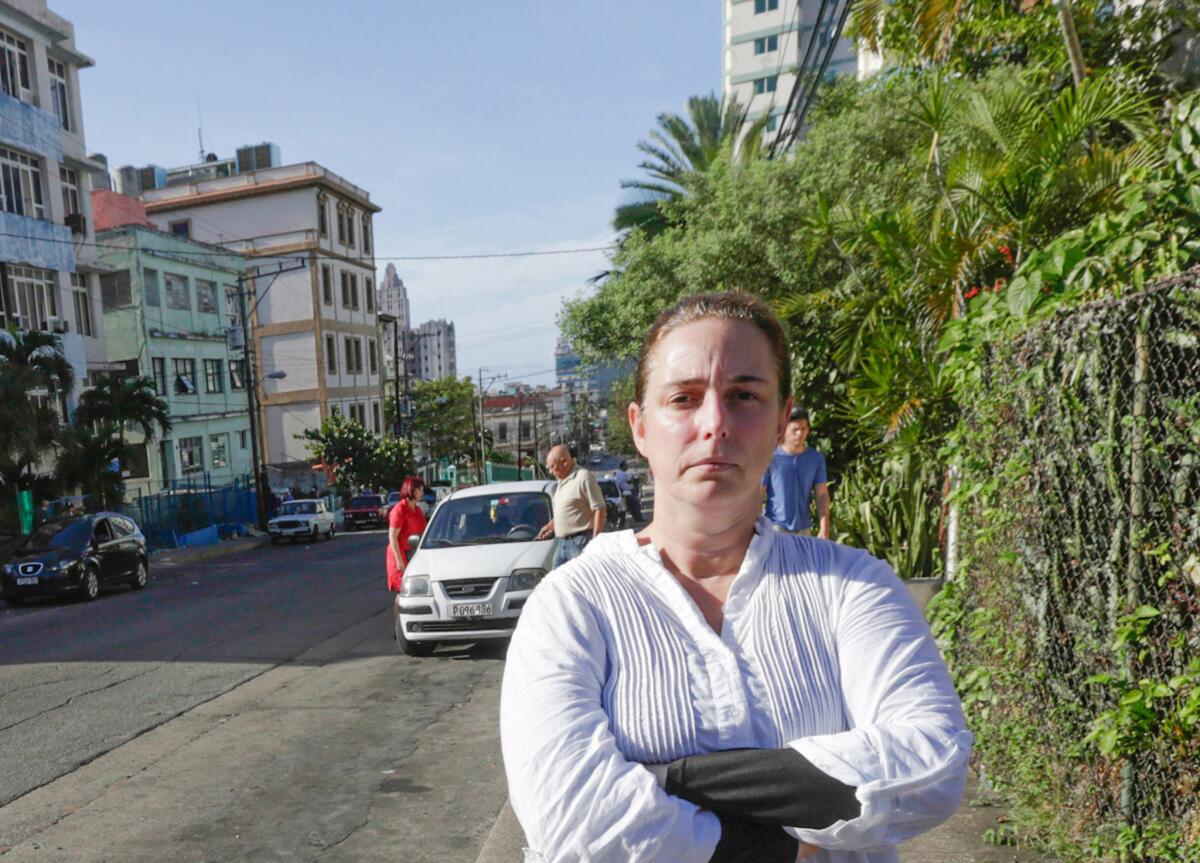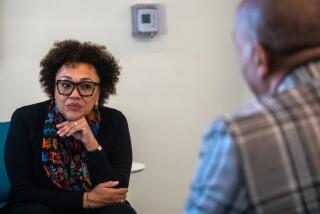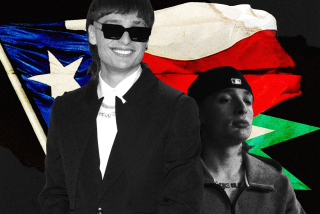Art and politics collide in Tania Bruguera’s latest work in Cuba

Cuban artist Tania Bruguera has always mixed politics into her art — along with a good helping of provocation. For a performance at London’s Tate Modern in 2008, she had police officers burst into the museum and practice crowd-control techniques on spectators. The following year, at the Venice Biennale, she delivered a lecture about art and politics while playing Russian roulette with what she claimed was a loaded .38 pistol. That same year, she distributed trays of cocaine at a panel on leadership she organized at a humanities festival in Bogota, Colombia.
Bruguera — a Cuban national who lives and works primarily in the U.S. and Europe — has had her work both celebrated and denounced. But an attempt to stage a performance about free speech in Havana’s Revolution Plaza last week got the artist detained and released on three separate occasions over three days. Several of her Cuban supporters, along with unrelated dissident activists, were also arrested last week.
The arrests generated an outcry on social media. A petition demanding Bruguera’s release, along with that of the other detainees, got more than 2,000 signatures worldwide. In addition, the U.S. State Department issued an official condemnation.
But her actions have also drawn fire from art world insiders both in Cuba and abroad, with some criticizing her brash methods and willful defiance of the law.
“Tania will leave Cuba with another ‘goal’ for her artistic resume ... she will be critiqued and celebrated,” wrote Havana artist Lázaro Saavedra González on the cultural blog “Enrisco,” adding that it was easy for Bruguera to parachute in and demand free speech without fearing too much in the way of consequences. “In this country, there will remain thousands of Cubans fighting for civil rights.”
During an interview via telephone from her home in Havana on Tuesday, Bruguera acknowledged that her status as an internationally recognized artist had given her some level of protection.
“I know I have privilege,” she said. “An artist cannot solve the problem of the whole society, but you can do something with your privilege.”
Despite the international uproar, Bruguera insisted that her attempted performance was not a failure.
“It was a success,” she said. “It shows the moment we are at politically.”
The piece Bruguera attempted to stage, “Tatlin’s Whisper #6,” is quite simple: The artist sets up a podium and a microphone and invites members of the public to express themselves for a period of one minute each. She did the piece once before in Cuba without incident, at a contemporary art center during the Havana Biennial in 2009. But for this incarnation, Bruguera wanted to take her work to the street — specifically to Revolution Square, a popular site for government-sponsored political rallies.
“I had a Plan B,” she said. “Plan B was to have it between the National Museum of Arts and the Museum of the Revolution. It was perfect, because it was between art and politics, which is where my work lies. But I wanted to do it in the public space where passersby could participate. That was important.”
Cuba’s National Fine Arts Council made it clear from the get-go that Bruguera would not receive permission to do the piece in an outdoor public space and tried to persuade her to do it inside a cultural venue. Bruguera, however, would not be dissuaded. On Dec. 29, she announced via Facebook under the hashtag #YoTambienExijo (I Also Demand) that she would stage “Tatlin’s Whisper #6” in Revolution Square whether she received permission or not.
“If the people want to be there,” Bruguera said in a press release that day, “nobody will be able to stop it.”
But it was stopped. The artist was arrested hours before the afternoon event was to take place on Dec. 30. She was released the following day, but was then detained and released two more times over the following two days. She said she also was informed that she would have to remain in the country for two to three months while prosecutors pursued legal charges against her.
“They wanted me to sign the accusation,” she said. “They wanted me to say that the intention of the performance was to create a public disturbance. I said that was not the intention, and I refused to sign.”
She added that her computer and other equipment had been confiscated, along with her passport, which is still being held.
“It was funny, because I had taken a white T-shirt and wrote #YoTambienExijo on it,” she recalled. “They took that and the pen I used to write it.”
Bruguera’s thwarted performance has certainly gotten the attention of the art world — both in Cuba and abroad. Supporters have rallied to her cause, with curators from the Tate Modern, the National Autonomous University in Mexico and Los Angeles’ Museum of Contemporary Art all signing the petition that demanded her release.
Moreover, some prominent international curators have floated the idea of boycotting the 12th Havana Biennial, which opens in May. But the proposal, along with the related hashtag (#BoycottHavanaBiennial), haven’t gotten much traction.
Cuban American artist and scholar Coco Fusco, who is based in New York, published a thoughtful recap and analysis of the whole situation in the e-flux journal. She critiqued Bruguera’s actions on a number of points — among them, that a lot of coordination for the piece was done on the Internet, a medium to which very few Cubans have any regular access. That means the piece played out in a bigger way on the international stage than it did in Cuba.
Bruguera responded that her event was promoted in forums besides the Internet, including text messaging, phone calls and simple word of mouth. “There is a lack of resources to communicate,” she said, “but we did as much as we could.”
Even Fusco concedes that Bruguera’s piece has shone an interesting light on the international art world’s complicated relationship with the Cuban state — be they the institutional partnerships that have sprung up in recent years or the collectors and curators who descend in droves to visit Havana’s exhibition halls and artist studios.
“It may well be time for art world cognoscenti,” she writes, “who have for so long been charmed by Cuba’s eccentricities, anti-imperialist rhetoric and relatively cheap art prices to consider what, beyond the convention of indignant public letters, might serve as a valid response to a state that imposes draconian measures to enforce its hegemonic control over public space and discourse.”
Bruguera said she was inspired to re-stage “Tatlin’s Whisper #6” partly for that reason.
“Right now, it’s a very critical moment for the arts here,” she says. “[The state wants] to promote art, they use the contemporary language of art. But it’s without the critical apparatus that comes with it. So, ‘Let’s hold an event on the street’ — but without questioning. ‘Let’s do something’ — but without creating a platform where people can analyze what’s going on in their lives ... It’s quite problematic.”
Bruguera, meanwhile, has returned a government arts award from the Cuban National Union of Artists and Writers, and she’s waiting to see whether prosecutors proceed with a legal case against her. And if not, whether she will have her passport returned. In recent days, she says state police have intimated that perhaps it would be best if she were to just leave the country.
“If I leave the country without having the process completed,” she points out, “I could be accused of being a fugitive and not be allowed to come back.”
She adds defiantly, “I am not going until this process is finished.”
Twitter: @cmonstah
More to Read
The biggest entertainment stories
Get our big stories about Hollywood, film, television, music, arts, culture and more right in your inbox as soon as they publish.
You may occasionally receive promotional content from the Los Angeles Times.






